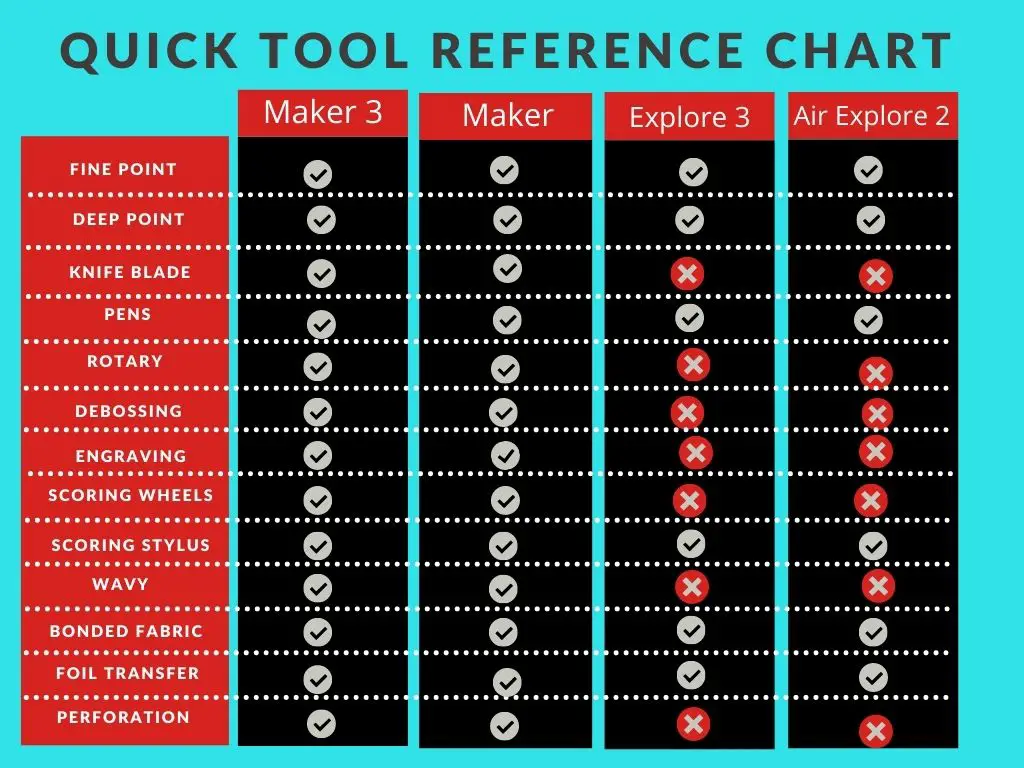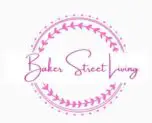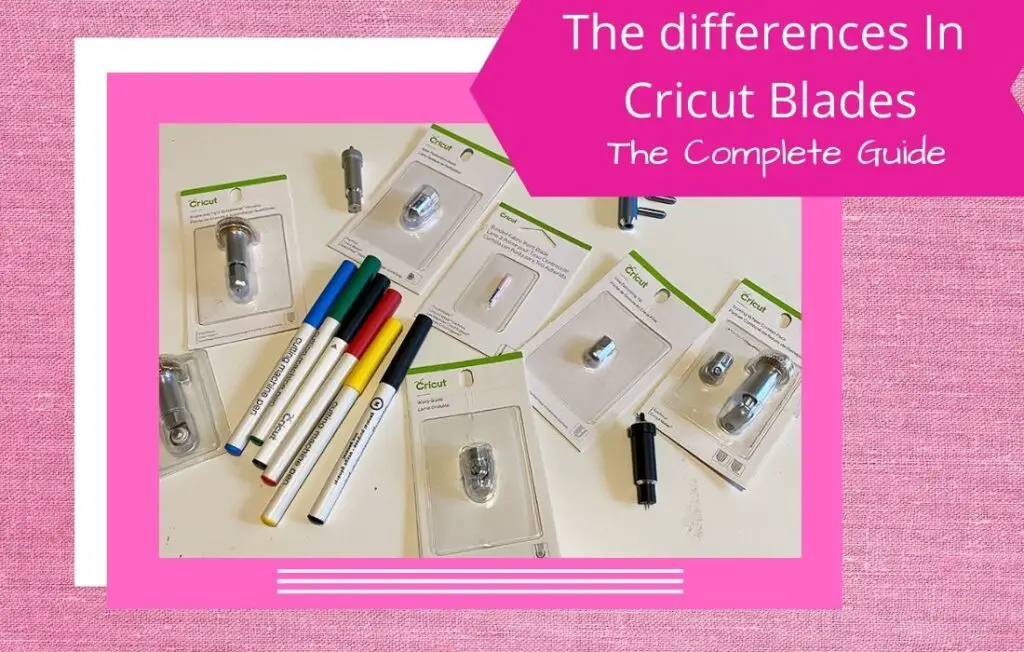This website contains affiliate links. As an affiliate, I earn a small commission from qualifying purchases (at no cost to you).
There are so many different Cricut Cutting machines that sometimes it is hard to pick the right one for you. Once you have your machine, it’s even more important to understand the different Cricut cutting blades.
Knowing what the different Cricut cutting blades are and when to use them will help you get the most out of your cutting machine. Not to mention, it makes your project go together smoother when you use the right tool for the right job.
Depending on the Cricut cutting machine you have will dictate which Cricut cutting blades you can use. There are 13 tools, and not all machines can use all of the tools or blades. The Cricut Maker 3, 4 and the Cricut Maker can use all 13.
What are all the different Cricut cutting blades?

The following is a list of all the current Cricut cutting blades and tools
- Fine point cutting blade
- Rotary Blade (attached housing)
- Knife blade (attached housing)
- Engraving Tip ( quick swap housing)
- Debossing Tip (quick swap housing)
- Perforation blade (quick swap housing)
- Wavy blade (quick swap housing)
- Single Scoring wheel (quick swap housing)
- Double Scoring wheel (quick swap housing)
- Scoring stylus
- Deep point blade ( in housing)
- Bonded fabric Blade ) in housing)
- Foil Transfer housing – with three tips -fine, medium and bold
- Pens and markers
How long do Cricut cutting blades last?
There is no definitive answer to that question. Cricut blades and tools are just like everything else. The more they are used the sooner they need replacing.
I use my fine-point blade frequently. I am cutting adhesive and Heat transfer vinyl more often than anything else. I use my cutting machines 3 to 4 days per week. My Cricut maker is used most often and in the last year and a half, and I have only replaced my fine point blade once (just recently after 19 months with one blade).
Caring properly for all of the different Cricut cutting blades and tools will keep them lasting longer. Store your blades and tools so that they are not bumping up against other tools, causing nicks and scratches in your tools. Be sure to store cutting tools and tips with the protective plastic cover that comes with the blade.
Cleaning the different Cricut cutting blades after use, will also make them last longer and give you cleaner, smoother cuts. A simple way to clean them is to make a ball of aluminum foil and poke the blade in and out of the ball 30- 40 times after every few uses. This will remove any stickiness, or cardstock dust and debris from the blade.
The individual different Cricut Cutting Blades and tools.
THE FINE POINT BLADE
This is the most commonly used blade. You may see this referred to as a premium fine point blade, to the German fine point blade. It is also available in gold and silver. The important thing to remember is that they are all the same.
The fine Point blade is the standard blade that comes with the Makers, Explores and the Joy machines.
The fine point blade is used to cut :
- Adhesive vinyl
- removable vinyl
- heat transfer vinyl
- cardstock
- infusible ink
- some poster board
- faux leather
- waterslide paper
- sticker paper
- Smart materials (smart cardstock and smart vinyl)
- some foils
- and more
THE DEEP POINT BLADE
The deep point blade cuts deeper than the fine point blade and at a steeper angle (60 degrees). The deep point blade allows you to cut thicker materials and still be precise. The deep point blade is black.
The deep point blade is used to cut :
- chipboard
- thick cardstock
- craft foam and EVA foam
- neoprene – perfect for making can koozies
- stencil material
- magnet sheets
- some cardboards
- and more
THE ROTARY CUTTER
The Cricut Rotary cutter is another tool that I get a lot of use out of. Use the rotary cutter on soft fabrics, such as fleece, felts, chiffon and cotton. For anyone who does quilting or appliques, this is an awesome tool. Cuts perfect circles, and patterns with ease and beautiful straight cuts. There is no need to add a backing or use bonded fabrics.
Replacement blades are available and come with a tool to change out the cutter on the housing.
The Rotary Cutter can be used to cut:
- Most fabrics (no need for bonding)
- crepe paper
- tissue paper
- aluminum foil
- lace
- felt
- and more…
THE ENGRAVING TIP
The engraving tip with the quick swap housing is a very cool tool. It is a definite must-try for die-hard crafters. The quick swap housing means that you only need to purchase the tip if you wish. The engraving tip is made from carbide steel, making it a versatile tool for many engraving projects.
The engraving tip can only be used on the Cricut Maker and the Maker 3.
The engraving tip can engrave on the following:
- Acrylic blanks
- soft metals, such as dog tags, name plates and jewellery pieces.
- leather *Cricut brand or must be very thin)
- plastic
- aluminum
- and more
Engraving is done on a flat surface adhered to your cutting mat. For jewellery, the pieces are shaped after the engraving process is complete.
THE DEBOSSING TIP
What is the difference between Debossing and Embossing?
Debossing is pressing the design into the cardstock, and embossing is raising the design up.
Anyone who has done embossing before will remember the folders or sleeves you have to put your cards into and then roll them or apply pressure with a tool to do the embossing., This tip makes that process seamless. No folders or sleeves, just attach the tool and let the machine do the work. Even though the design is not embossed and is debossed instead, I find the look to be more pleasing. Depending on your design, you may get an embossed look for the completed project.
The Debossing tip works with the Quick swap housing and with the Cricut Maker 3 or the Maker.
The Debosasing Tip works on the following materials:
- Cardstock ( excellent results)
- foil cardstock (love this for making gift boxes)
- poster board
- craft wrapping paper
- and more.
The debossing tip is a great way to add flair to gift tags, cards, book covers and gift boxes.
Some ask if the debossing tip can be used in place of the scoring wheel or vice versa. The debossing tip creates a deeper crisper line than the scoring wheel. I have used the debossing tip for score lines on thicker materials, but as a rule, I don’t interchange the two.
THE PERFORATION BLADE
The Perforation Blade is perfect for making anything that you would want to punch out, such as tickets, paper doll sets, coupons, tearaways, window cards and my favourite, the Advent Calendar.
The Perforation Blade uses the quick swap housing and is compatible with the Cricut Maker 3 and the Maker.
The Perforation blade works with the following materials:
- Cardstock ( medium to heavy weight is best)
- cardboard (not always the greatest)
- Poster board.
- Thin acetate sheets
- Kraft-tex (paper leather)
- and more
THE SCORING WHEELS (SINGLE AND DOUBLE)
The scoring wheel(s) are perfect for making crisp, straight fold lines. These are great for making boxes, origami fold lines, crease lines for cards, and fold lines for making home decor items, such as paper flowers, houses and candle covers.
What is the difference between the scoring stylus and the scoring wheels?
The Scoring wheels apply 10 times the pressure compared to the scoring stylus. If you have a Cricut Maker 3 or a Maker, definitely go with the scoring wheels. The scoring wheels are compatible with the Maker3 and Maker only. The scoring stylus can also be used on the Maker 3 and the Maker, the Air Explore 2 and the Explore 3.
The Scoring Wheels work well with the following materials:
- Paper (excellent on origami paper)
- Cardstock (all weights)
- acetates and window films
- poster board
- crepe and tissue paper
- Kraft-tex (paper leather)
- and more
THE WAVY BLADE
The Wavy Blade is perfect for cutting wavy edges. The cuts are flawless and so clean. I use my Wavy blade to make wavy-edged gift tags, stickers, paper flowers and cupcake toppers. The wavy blade is a wheel that is used with the quick swap housing.
The Wavy Blade works well with the following materials.
- Vinyl (HTV, Adhesive)
- infusible ink
- paper
- cardstock
- crepe paper
- poster board
- foil
- some fabrics
- and more
The Cricut wavy blade is compatible with the Cricut Maker 3 and Maker.
THE KNIFE BLADE
The Knife blade is specially designed for cutting thicker materials. It is great when making leather jewellery, small purses and shoes, book covers, puzzles, picture frames and mats and more. The knife blade uses the quick swap housing.
The knife blade is compatible with the Cricut Maker 3 and the Cricut Maker only.
The Cricut Knife Blade can be used on the following materials:
- Basswood (1/16″)
- Balsa wood (3/32″)
- leather ( up to 7 oz)
- mat board (2 ply or 4 ply)
- craft foam
- chipboard (2mm)
- garment leather (5 ounce)
NOTE – using the knife blade requires much longer cut times. It must also be used with a Bluetooth connection. Turn off sleep mode so that there is no interruption. If the power or Bluetooth is interrupted, your project could be cancelled.
THE BONDED FABRIC BLADE
The bonded fabric blade allows you to cut backed fabrics for projects like appliques, iron-on and stabilized fabric for purses or bags.
What is Bonded Fabric?
Bonded fabric is a fabric that has an adhesive bond attached, such as Heat N Bond or iron-on strong interfacing. For example, you might use this if you were making fabric lunch bags or Christmas sweaters. An adhesive backing, such as Heat n Bond, is added to a piece of fabric before cutting. Once the fabric has the bond applied, you can then use your Cricut bonded fabric blade to cut out detailed pieces, such as designs for the front of the lunch bags or Christmas reindeer or snowmen for the Christmas sweater.
The bonded fabric blade is compatible with Cricut Maker, Cricut Maker 3, Explore 3, Air Explore 2, Explore 1 and the Explore Air. The bonded fabric blade is Pink (for easy organizing)
To cut unbonded fabrics, you will need a Cricut Maker and a rotary cutter.
Fabrics that are compatible for use with the Bonded Fabric Blade
Most fabrics that can be bonded can work with the bonded fabric blade. The bonding is applied using a heat press or iron, so the fabric will need to withstand the heat during the application of the bond.
After trying several fabrics, I have found that cotton, such as quilting fabric, has given me the best results.
I suggest applying the bond to a small piece of your fabric and testing the cut before applying the bond to a large piece.
THE CRICUT FOIL TRANSFER TOOLS
The Foil Transfer tools come in a set. There are three different-sized tips and a housing. The foil transfer tips work with foil transfer sheets (available in multiple colours). The foil sheet is placed onto your chosen project, such as cards, gift tags or labels, and the design is imprinted into the surface. Once completed, you peel off the foil sheet to reveal your finished project.
The foil transfer kit is compatible with the Cricut Maker 3, Maker, Air, Explore 2, Explore 3 and the Joy machines.
The foil Transfer sheets can be used on:
- Paper
- Cardstock
- faux leather
- and more
NOTE – The foil transfer kit must be used with a computer and is not compatible with device apps.
When placing the foil onto your project on the cutting mat, be sure to use the provided tabs and make sure it is wrinkle-free. DO NOT allow foil sheets to touch the sticky part of your mat, as it will stick and damage the foil.
Cricut Pens and Markers
The Cricut pens and markers are a great addition to your crafting projects. The pens come in many colours and tip sizes. Metallics and colour sets, as well as gel pens, are available. The Cricut pens are made to fit into the Cricut machines, so be careful when purchasing off-brand pens. Most need an adapter or do not work in the Cricut Machine.
The Cricut Pens work in all of the Explore machines and the Maker’s as well as the Joy. Check the packaging before you buy as some pens are machine-specific, such as the Cricut Joy opens.
The Cricut writing tools can be used on any writable surface that can be used in your cutting machine.
THE CRICUT SCORING STYLUS TOOL
The Cricut scoring stylus tool is used to score lines for folding and creasing when making projects such as cards, boxes, gift bags or 3D art. The Scoring stylus does not use as much pressure as the scoring wheels, but can be used in machines that are not compatible with the scoring wheels.
The scoring stylus is compatible with the following materials:
- Crepe paper
- card stock
- aluminum foil
- paper
- poster board
- paper
- acetate
- and more
QUICK CRICUT TOOL REFERENCE CHART

About the plastic covers on some blades and tools.
Some of the different Cricut cutting blades and tools, such as the quick swap housing and rotary cutter, have a wheel with a plastic cover on the housing. Do not remove the plastic cover. When inserting your tool, the rounded side of the cover faces out and makes proper insertion easy. Your cutting machine will then go through a process where it recognizes the tool and prepares for the cut.
What do the numbers mean on the side of the tools?
Each Cricut Quick Swap housing tip has a unique number. If you choose to organize your tips using numbers, it is an easy way to identify your tools, but most people choose other methods of organization.
Reference for Cricut Maker tool numbers.
- 01 – Single scoring wheel tip
- 02 – Double scoring wheel tip
- 11 – Perforation blade tip
- 21 Debossing Tip
- 41 – Engraving tip
I hope that you found this post informative and that it contained all the information you need regarding the different Cricut cutting blades and tools.

This website contains affiliate links. As an affiliate, I earn a small commission from qualifying purchases (at no cost to you).


